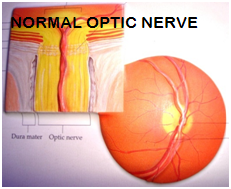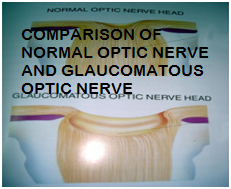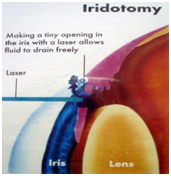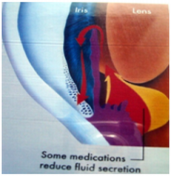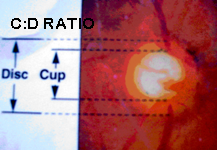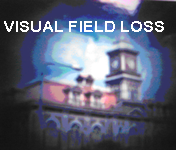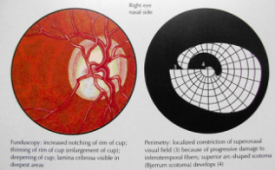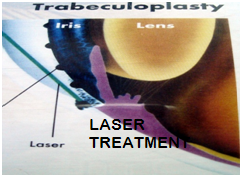Glaucoma is disease of optic nerve where increased
intraocular pressure in the eye causes damage to
the optic nerve. It is one of the leading causes
of blindness in our country. Our eye secretes
clear fluid called aqueous humor which helps in
the supplying the necessary nutrients to the eye.
This also helps in keeping intraocular eye pressure
within normal limits. Usually the fluid produced
is balanced by the fluid draining out, but when
drainage angle is blocked, the fluid pressure in
the inner eye increases. When aqueous humor gets
clogged the damage occurs because there is
weakness in the optic nerve.
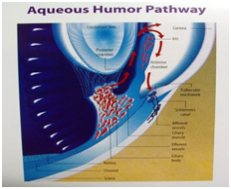
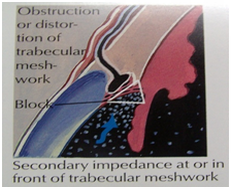 ANGLE - CLOSURE GLAUCOMA
ANGLE - CLOSURE GLAUCOMA
Angle-closure glaucoma is caused by a sudden increase in the intraocular pressure (IOP) inside the eye, where the iris (the colored part of the eye) is pushed or pulled up against the trabecular meshwork (or drainage channels) at the angle of the anterior chamber of the eye and so the fluid (called aqueous humor) that normally flows out of the eye is blocked and cannot drain out, thereby increasing the IOP. The damage to optic nerve depends on how much pressure there was and how long it has lasted, and whether there is a poor blood supply or other weakness of the optic nerve.
People who are farsighted (called hyperopia) are at an increased risk for acute angle-closure glaucoma because their anterior chambers are shallow and their angles are narrow. Sometimes, the attack may be caused by dilation of the pupils, during an eye examination, after visualizing a movie.
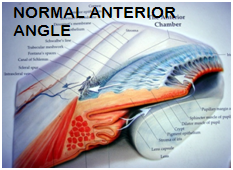
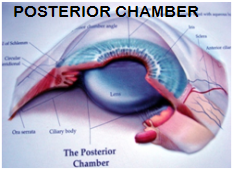
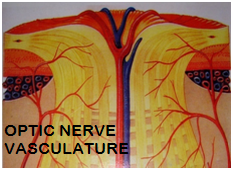
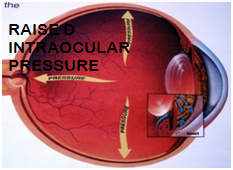 SYMPTONS
SYMPTONS
- Severe eye pain
- Nausea and vomiting
- Headache
- Blurred vision
- Seeing colored haloes around lights
- Profuse watering
TREATMENT
Immediate treatment is essential to prevent optic nerve
damage and vision loss. Initial treatment is depends on
the clinical findings and will be either topical drops
supported by systemic treatment to clear the cornea of
cloudiness and lower the IOP. When the conditions are
appropriate then a Laser iridotomy/Surgical Iridotomy is
the treatment of choice for angle-closure glaucoma. In
Indian-Asian patients, Laser iridotomy may have to be
repeated and at times doesnít give desired results. If,
however the Ophthalmologist feels the condition chronic
or more extensive she may opt for other surgical
procedures available.
PRIMARY OPEN ANGLE GLAUCOMA
Popularly known as the silent killer, in primary open angle glaucoma there is damage to the optic nerve gradually caused by blockage of drainage channels-sieve like trabecular meshwork and the angles are open.
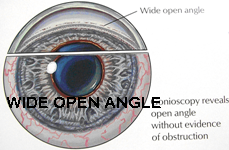
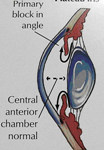
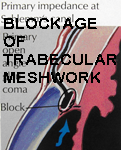 SYMPTONS
SYMPTONS
-
There may be no symptom until quite a bit of visual loss has occurred. This is because the first part of the vision to 'go' is the outer (peripheral) field of vision. Central vision, used to focus on an object such as when we read, is spared until relatively late in the disease. Also, although glaucoma usually affects both eyes, it may not affect them equally.
- Rainbow colored haloes around light, foggy vision esp. the peripheral blurry vision.
- Inability to adjust the eyes to dark rooms.
- Headache
- Frequent change of the eyeglasses
- Sometimes diagnosed in routine examination of eyes.
- Family history, high myopia, diabetes
- Moe common in African ancestry
- Extended steroid medications- systemic or topical
Some elderly people with glaucoma put their gradual failing vision down to 'just getting old' or getting cataract. They might not have had their eyes checked for many years and may needlessly lose their sight. The increased pressure in the eye can damage the optic nerve (the main nerve of sight) which leads to permanent vision loss.
PREVENTION IS BETTER THAN CURE
Regular eye examinations with an
ophthalmologist may identify people
who are at risk for acute angle-closure
glaucoma. The eye test normally includes:
-
Measurement of the eye pressure.
-
Fundus evaluation for cup: disc ratio
of the optic nerve - Checking
the field of vision with automated
perimeter.
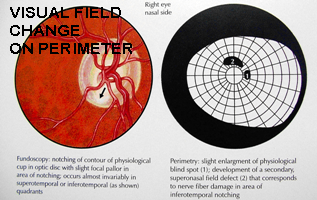
People aged over 40 with a first-degree relative (mother, father, brother, or sister) with glaucoma should have checkup frequently.
TREATMENT
-
Eye drops - They reduce the
amount of aqueous humour or
increase the drainage of
aqueous humour.
-
Tablets - used mainly in acute
phases. Long-term use of the
same is not advisable because
of their side-effects.
-
Surgery - Trabeculectomy-This
involves creating a channel
between inside the eye to just
under the conjunctiva. So, the
aqueous humour can bypass the
blocked trabecular meshwork.
Like with all operations, there
is a small risk of complications
including fast ripening of cataract.
Also the operation may have to be
repeated in some cases. This is
usually because some scar tissue
forms at the site of the channel
and prevents it working to drain
the aqueous humour.
-
Laser treatments by burning the
trabecular meshwork which
improves the drainage of the
aqueous humour or to destroy
parts of the ciliary body which
reduces the amount of aqueous
humour that is made. However,
the reduction in eye pressure after
laser treatments often only lasts
a short time and Indian eyes donít
respond as effectively.
SECONDARY GLAUCOMA
In some patients glaucoma may develop as a 'secondary' complication to hyper mature cataract, Liberation of lens particles, some eye injuries, eye operations.
CONGENITAL GLAUCOMA ( BUPHTHALMOS )
The glaucoma is present from birth. Immediate and active treatment is must. Congenital glaucoma may be a part of some systemic disease like apertís anomaly or other caniosyntosis also.












